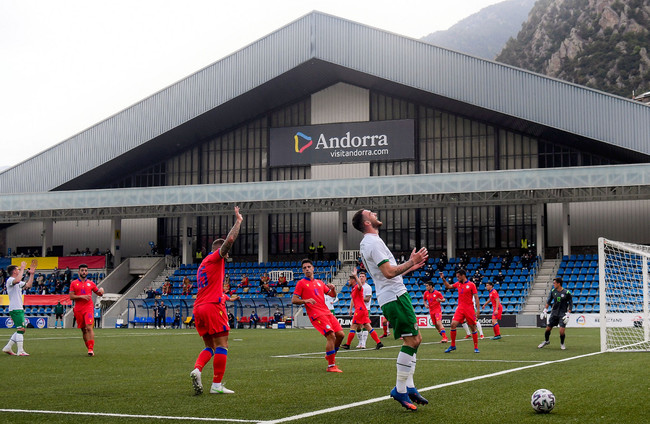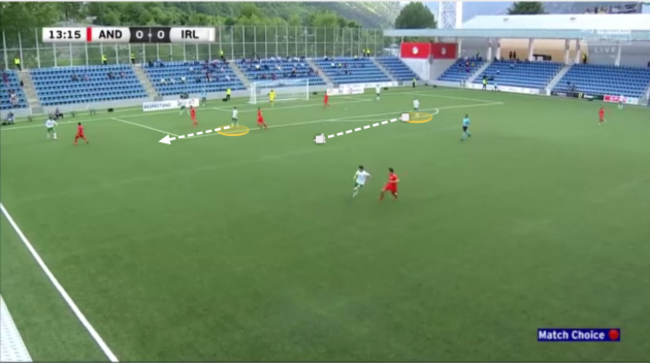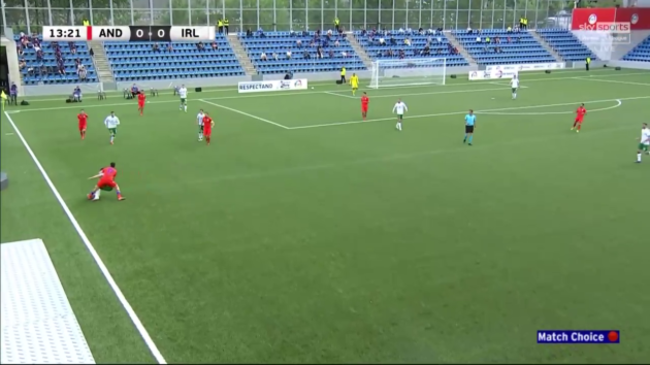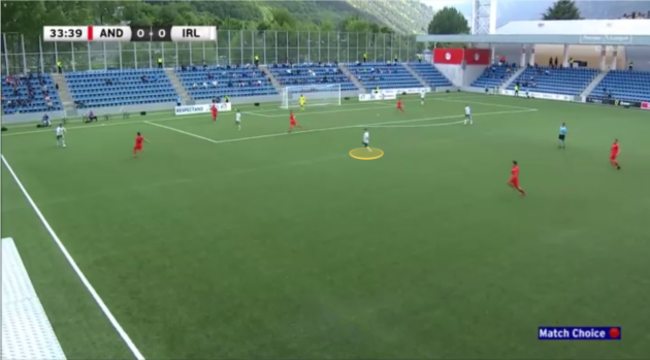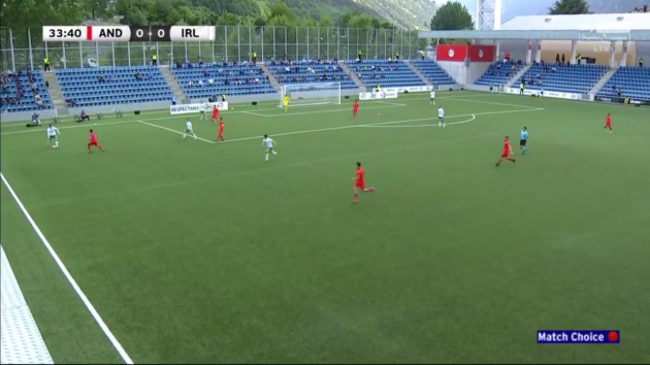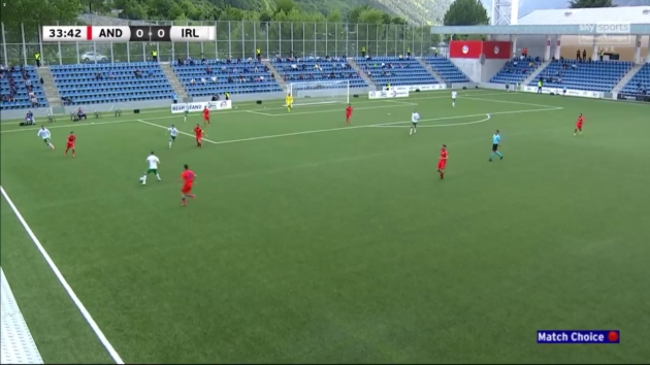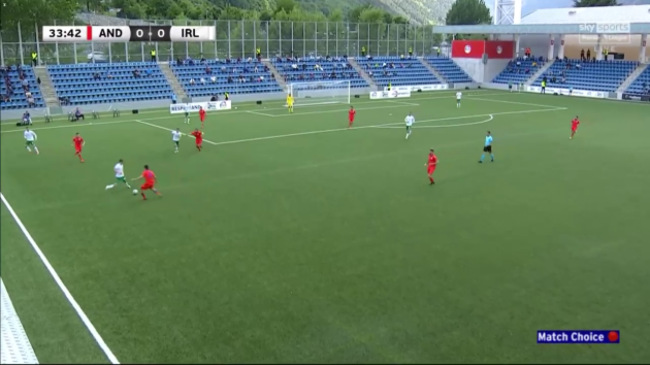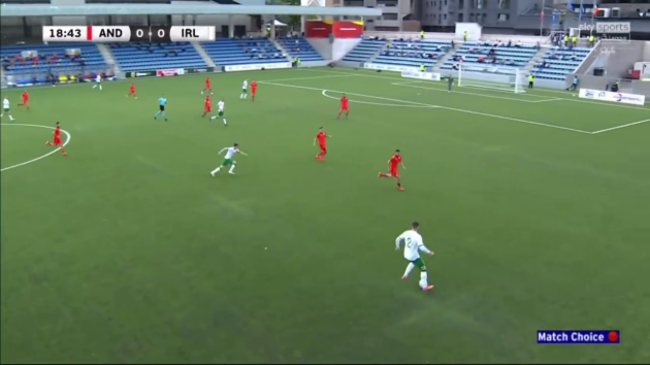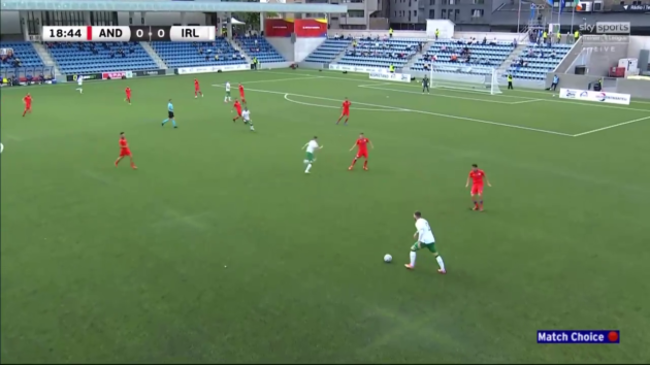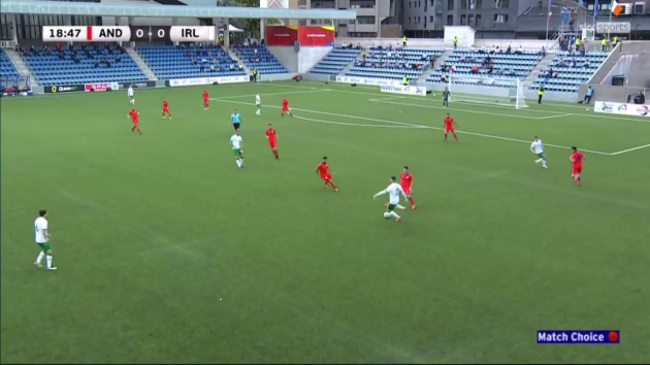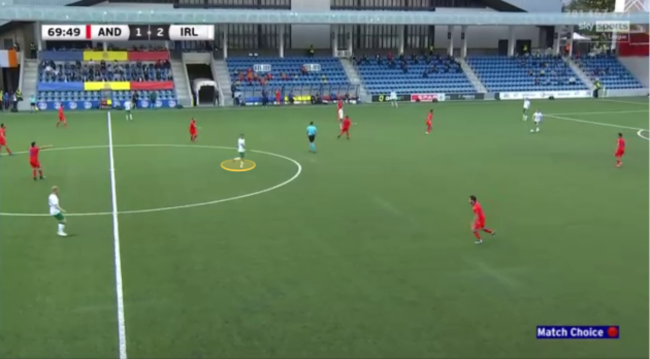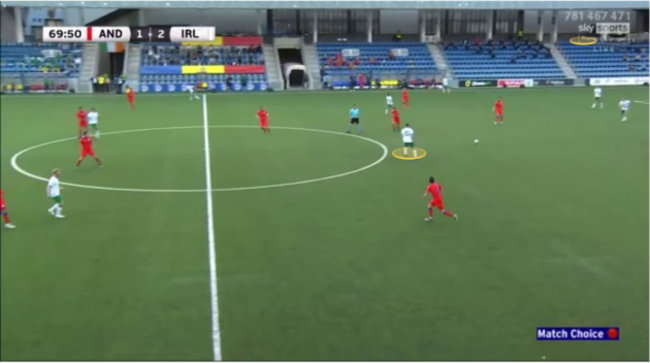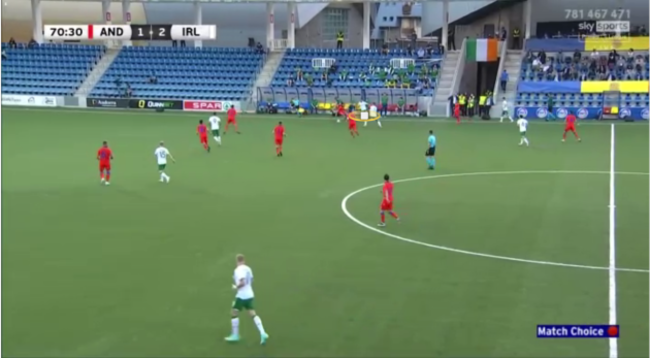FINDING A CONSENSUS on Ireland under Stephen Kenny has been largely impossible thus far, with John Delaney’s mad succession plan digging the trenches for an ongoing culture war as to how the Irish team should play: hipsters and football’s high priests on one side, dinosaurs on the other.
There does seem to be something approaching an agreement on how to feel about last night’s victory against Andorra, however: a good win to erase the ‘winless’ prefix from match preview pieces, but a poor performance offering more worry that encouragement.
You can argue that taking that line after 4-1 victory seems mildly harsh on Stephen Kenny’s team, given this was the first time Ireland have scored four goals away from home since doing so against O’Man in 2016 and the fact that only Hungary, Portugal, Latvia and France have managed at least four goals against Andorra since the start of 2019.
On the other hand: two of Ireland’s goals arrived in the final few minutes with the Andorran players jaded while playing a 41-year-old man playing at centre-back, and Ireland did briefly trail having conceded an utterly shambolic goal from a set piece.
First-half problems
Much of the vented frustration comes from Ireland’s zestless first-half performance when Andorra had more energy and Ireland largely replicated what we had seen in the dreadful defeat to Luxembourg in March.
At a glance, the first halves in both games were eerily similar: Ireland played at a low pace, lacked any zip to their passing and created one single good chance which James Collins contrived to miss. Against Luxembourg Collins at least hit the target: yesterday he flicked a header from Jason Knight’s excellent cross well wide.
Passing stats bear out the familiarity. According to WyScout, 59% of Ireland’s 286 first-half passes went either backward or sideways, which is their highest percentage in a single half this year. The next highest is – you guessed it – the first half against Luxembourg, where 55.9% of passes did not go forward.
Ireland look a much better side when they get the ball forward more quickly. That percentage was at its lowest this year in the first half against Serbia, at 47.28%, when Ireland could play on the counter-attack. That is also the only first half under Stephen Kenny in which they have scored from open play.
One option to get the ball forward more quickly is, obviously, just to knock it long, but Ireland don’t have the style of attackers to compete for second balls off a target man. But one of the main points of employing Stephen Kenny as manager is not to do this, and for years it has been neither effective nor entertaining.
Deja vu all over again
Kenny is well aware of Ireland’s need to pass the ball forward more quickly from midfield, and the Irish squad have been working on it in camp since last Friday, but an emerging issue is simply getting the ball to the midfielders in the first place.
Yesterday’s first half again showed Ireland’s startling vulnerability to an opposition high press. We wrote about this problem after the Luxembourg game, when Ireland played a 3-5-2 and the opposition cornered the ball into what proved to be a left-sided disaster zone for Ireland, with Josh Cullen, Ciaran Clark and an admittedly half-fit Enda Stevens continually losing possession.
Clark and Stevens aren’t on this week’s trip, so Kenny reverted to a back four yesterday with Cullen in a midfield two with Conor Hourihane.
But Ireland created just a single chance and didn’t have a shot on target in the first half yesterday, and the same pressing problem reared its head again, this time often manifesting itself on the right-hand side of the Irish defence.
Not just a case of not having the players
Richie Sadlier said on RTÉ that the Irish players looked “bamboozled” by the Andorran press but Kenny did not agree, instead saying the issues were rooted in the positioning of midfield duo Hourihane and Cullen.
“They were dropping into areas too deep to receive it, in the fullback areas which sometimes can be very effective in controlling games against top class opposition but against opposition that are sitting off you, it’s not effective”, said Kenny.
“We needed to get Josh and Conor in central areas and further up the park and play good, incisive passes into them and let them link with the attacking players like they did in the second-half.”
You can argue that Ireland simply don’t have the players in midfield to take and pass the ball in tight situations – and it’s still depressing to think of the difference Declan Rice would make to this team – but more confidence, cohesion and urgency in the Irish ranks would go a long way to mitigating the technical shortcomings.
Take this instance in the 13th minute, as Matt Doherty finds himself pressed into the right corner having taken a goal kick. Firstly, Ireland are probably too deep on the goal kick: it’s rare to see a full-back, rather than a right-sided centre back, pressed so deep on a goal kick.
Nonetheless, the Irish players around Doherty don’t do enough to offer him an out-ball.
Cullen could drop off and offer a passing option, or draw his man with him and vacate space for Hourihane to pick up the ball centrally and get Ireland moving.
Had Cullen ran towards the ball, Doherty had space to play a simple pass ahead of Hourihane, who in turn could have played a first-time pass for Jason Knight – already setting off on a run – and Ireland would have been away.
Instead, neither of the midfield pair make any real movement, Doherty turned around twice, and ended up playing a ball up the line with Knight dragged deep and getting Ireland out by winning a foul.
A lack of urgency
Kenny also said one of the issues was that Jason Knight kept too far wide on the right in the first half, and thus blocked a route down the right wing for Doherty’s overlapping runs.
Here, though, Knight gets himself in a decent position in-field, and wants the ball…
Doherty can play the ball either directly to Knight or to him via Cullen in the penalty area, and then has oceans of space to break into and take the ball from Knight.
But instead Doherty dallies for a second too long, and instead plays a pass up the line which Knight runs on to and then loses while trying a Zidane-style pirouette.
If Mick McCarthy is reading this, be still your beating heart: Ireland’s main attacking weapon in this game was crossing.
The quality of Ireland’s delivery from play was excellent at times and Ireland’s second, third and fourth goals all came from pinpoint crosses from Hourihane, Daryl Horgan and Jason Knight.
Many other balls into the box caused chaos – Collins should have scored from another great Knight cross in the first half – but Ireland often didn’t show enough urgency to get into crossing positions. James McClean, in fairness, did inject that down the left flank, but often his final delivery was poor.
Doherty, by contrast, was exasperating down the right. Take this example: Knight is in-field – where Kenny wanted him – and lays a good pass off for Doherty, leaving him oceans of space for an overlap…
…which he doesn’t take, instead ambling onto the ball, stepping infield and into traffic, before playing the ball back to Cullen.
Doherty has spent so long as an underlapping wing-back for Wolves, he always seems to prefer taking an inside line – he contributed a decent mazy dribble to the edge of the box later in the half – but those movements are of little use if nobody is overlapping him on the right flank.
Seamus Coleman did this a couple of times against Luxembourg before Doherty went off injured at half-time, and thus Doherty was one of Ireland’s better players on the few occasions they could get the ball to him.
After years of asking whether the Irish manager would play Coleman or Doherty, it’s becoming clear he should be playing them both.
A lot of the above can’t just be explained away by dismissing the quality of the Irish players. Had they shown more urgency and conviction on the ball and perhaps more trust in the players around them. the Andorran press could have been beaten far more easily.
Kenny needs to fix this torpor.
The dodgy 4G surface in Andorra offers some mitigation for Ireland’s hesitancy in possession, as does the relative unfamiliarity of the formation (this was the first time under Kenny that Cullen and Hourihane played together in a midfield pair, for instance.)
Making the most of these passing triangles can be worked on, and at club level, enough repetition can automate them. Kenny’s issue is that he doesn’t have the same luxury of time in the international game.
Troy wonder
Okay, the game carries the asterisk of being Andorra, but it’s difficult to overstate how good Troy Parrott’s performance was. Most obviously, he scored two goals, might have had a penalty and should have had an assist, only for Ronan Curtis to fluff his lines from three yards out.
But Parrott also showed the leadership Ireland needed in being their main outlet up front: his movement and hold-up play was much better than James Collins.
A key stat when measuring a teams ability to transition quickly in attack is ‘progressive passing.’ There aren’t just forward passes, but completed passes that travelled a significant distance toward the opposition goal. In the first half Ireland played 35 of them, and Parrott received more of them than any other Irish player.
In the first half, with the midfield pair often too deep, Knight occasionally too far wide on the right and Curtis struggling to make any kind of impact from the left, some of these went wasted as he lacked options around him.
He made a more obvious impact in this regard in the second half through a combination of tiring Andorrans and the space created by Daryl Horgan’s introduction on the left flank.
On Virgin Media, Damien Delaney picked out a few moments from the second half in which Cullen and Hourihane were either not demanding the ball in midfield or conservative in their passing – it’s well worth a watch.
Parrott sometimes dropped off to compensate. Again the Irish midfield are quite deep here, but Parrott demands the ball…
…spins it out to James McClean on the left, and just over 30 seconds later is on the right wing, combing neatly with Doherty in a move that ultimately broke down.
Ireland have lacked a player to make those movements since David McGoldrick’s retirement, and though there are plenty of understandable comparisons with Robbie Keane, Parrott may prove to be a more natural successor for McGoldrick.
What next?
Ireland will need to be better against Hungary next Tuesday, who are obviously much better than Andorra and shouldn’t be wilting in the final quarter given the Euros Group of Death awaits them a few days later.
Stephen Kenny, meanwhile, has talked about never betraying his passing principles, but now he needs to transmit them to the players. Sharpish.
